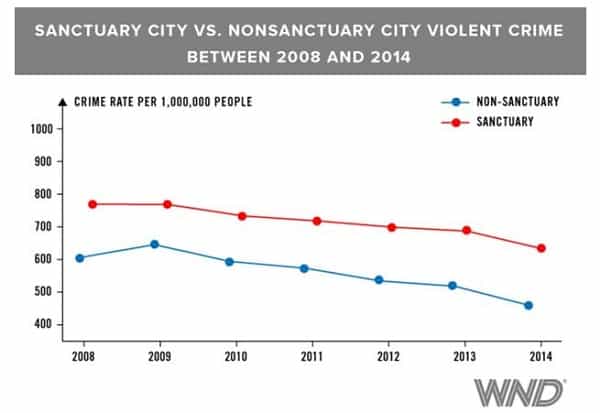Data In! Sanctuary Cities Have Higher Crime Rates
Alicia Powe, WND, April 9, 2017

Surprise! Sanctuary cities do, indeed, experience higher crime rates than do non-sanctuary cities, an in-depth WND analysis of the most recent study of the question reveals.
An August 2016 study of the relationship between “sanctuary city” policies and crime rates shows that cities refusing to cooperate with federal immigration authorities consistently have significantly higher violent crimes rates than do non-sanctuary cities with similar populations and demographics, WND has found.
The study, published last fall by researchers from the University of California-Riverside and Highline College in Des Moines, Washington, is frequently cited by proponents of “sanctuary cities” who ignore or downplay one important detail – the actual crime statistics of the carefully selected cities chosen for the comparison model.
An analysis of the data by WND reveals that non-sanctuary cities comparable in population, size and demographics consistently – year over year – experience and report lower percentages of violent crime as well as lower percentages of property crimes.
The authors of the study, researchers Loren Collingwood, Benjamin Gonzalez-O’Brien and Stephen El-Khatib, define a sanctuary city as “a city or police department that has passed a resolution or ordinance expressly forbidding city or law enforcement officials from inquiring into immigration status and/or cooperation with ICE.”
The authors admit their assumptions going into the study were that differences in crime rates would be negligible. And their stated conclusions are that’s what was found.
“Since undocumented immigrants face deportation in addition to criminal charges, it is logical that they would avoid breaking the law to a greater extent than the native born population,” they wrote. “We expect to see no statistically significant difference between sanctuary and non-sanctuary cities.”
In addition, their introductory comments on what they expected to find in the data included this statement: “We find it unlikely that sanctuary cities will have more crime – be it violent, property, or rape as claimed by some political candidates and opponents of sanctuary cities.”
However, their report buries the actual statistics. The statistics show, from 2000 through 2014, sanctuary cities have had higher crime rates than non-sanctuary cities, with the disparity growing over time.
The researchers examined 54 cities in 19 states, plus the District of Columbia – cities listed by the National Immigration Law Center that implemented sanctuary ordinances post-9/11, during or after 2002. Using city-level crime data compiled by the FBI, they assessed crime rates at the city level immediately following the implementation of a sanctuary policy.
They then matched each sanctuary city to a similarly situated non-sanctuary city – based on relevant census and political variables, creating a scenario where the two cities are as similar as possible with the exception of the sanctuary policy.
The researchers claim, in conclusion, that their study shows designating a city as a sanctuary has no statistically significant effect on crime.
“Our findings provide evidence that sanctuary policies have no effect on crime rates, despite narratives to the contrary,” they wrote.
{snip}
Data gathered in the study, however, overwhelmingly contradict the conclusions of the authors.
Violent crime rates are, in fact, drastically higher in sanctuary cities than their non-sanctuary counterparts, as is evidenced by the chart the authors used to delineate their conclusion.
{snip}
According to the Department of Homeland Security, from January 2014 to August 2014, more than 8,145 aliens were released from jail after arrest after their respective jurisdictions declined an immigration detainer request from Immigration and Customs Enforcement. Sixty-two percent of them had a prior criminal record, and 3,000 of them were felons. Of the 8,145 individuals released, 1,867 were subsequently re-arrested a total of 4,298 times and accumulated a staggering 7,491 charges.
{snip}
The Trump administration is cracking down on “sanctuary” cities and counties that do not cooperate with the federal government in enforcing U.S. immigration law. President Trump issued an executive order in January that gave Attorney General Jeff Sessions the authority to sanction any city that doesn’t readily hand over undocumented immigrants for deportation.
{snip}
The U.S. Department of Homeland Security reported in February that 10 sanctuary jurisdictions refused ICE’s detainer requests to hold 540 criminal aliens in just a one-week period.
{snip}
WND attempted to contact the authors of the August study for comments about conflicts between the data they gathered and their conclusions, but they did not reply to the inquiries.















